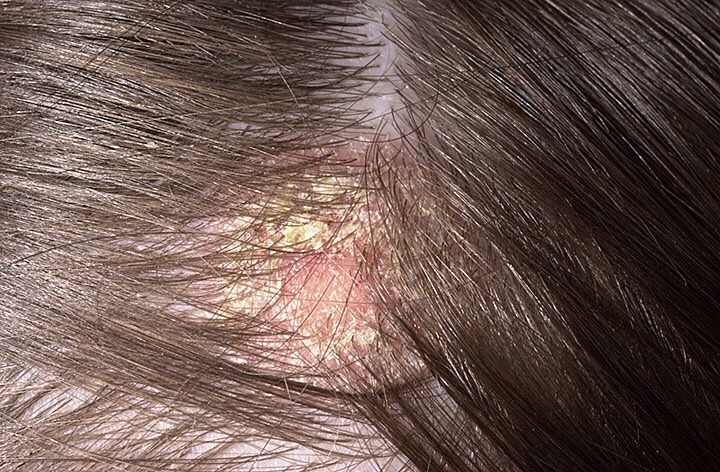Usually beginning on the scalp as oily, waxy patches, this common type of eczema sometimes spreads to the face and beyond. A severe case, while rare, produces widespread lesions. Like most types of eczema, seborrheic dermatitis tends to flare in cold, dry weather.
Seborrheic Dermatitis is also referred as:
- Seborrheic eczema
- Cradle cap (occurs in infants aged 0 to 6 months)
- Dandruff
- Seborrhea

At High-risk
The following tend to increase the likelihood of developing seborrheic dermatitis:
- A family history of eczema
- Having oily skin or hair
- Stress
- Fatigue
- Cold, dry climate
- Gender: Males tend to develop more often and have more severe cases
- Obesity
- Injury to the skin, such as an abrasion or scratch
- Using lotions or other topicals that contain alcohol
- Having acne, rosacea, psoriasis, or blepharitis (inflammation of the eyelid)
- Some medical conditions (Parkinson's disease, human immunodeficiency virus (HIV), and recovering from a stroke or heart attack) increases the risk significantly. Estimates indicate that as many as 90% of HIV-infected individuals develop seborrheic dermatitis.
- Taking certain medications, including interferon- α, lithium, and psoralen, significantly increases one's risk.
- Develops in all races
- People who have the human immunodeficiency virus (HIV), Parkinson's disease, or congestive heart failure often develop seborrheic dermatitis.
- Tends to begin during infancy (newborn to 6 months), puberty, or between 40 and 70 years of age. After 6 months of age, the condition rarely appears before puberty. When seborrheic dermatitis begins during infancy, it usually clears by 9 to 12 months of age.
Causes
While the exact cause is not known, researchers believe that a number of factors interact to cause seborrheic dermatitis. These factors include the genes we inherit, yeast that normally live on human skin, stress, climate, and overall general health.
Treatment
While seborrheic dermatitis cannot be cured, most cases respond quickly to proper treatment. The goals of treatment are to loosen and remove scales and crusts, prevent skin infections, as well as reduce the inflammation and itch.
Treatment varies by age and area of the body to be treated:
Infants (scalp):
Cradle cap, which only develops in infants, can usually be controlled by shampooing more frequently with a baby shampoo and by softly brushing away the scales. A dermatologist also may prescribe a mild corticosteroid or anti-fungal medication.
Infants (beyond the scalp):
When the condition spreads beyond the scalp in infants, dermatologists usually prescribe a topical medication, such as a mild corticosteroid or anti-fungal cream.
Patients with seborrheic dermatitis may find that shampooing more frequently than usual and leaving the lather on the scalp for a longer time clears the condition. Shampoos specially formulated for dandruff relief are often effective. Sometimes getting results requires alternating dandruff shampoos so that a different shampoo is used every few days. A dermatologist can explain this process and recommend which shampoos a patient should use and when. To effectively treat the scalp, a dermatologist also may prescribe a topical corticosteroid or antifungal medication.
Adolescents and adults (beyond the scalp):
Medicated dandruff shampoos often provide relief beyond the scalp. A dermatologist can explain how to use shampoo to treat other affected areas. A topical corticosteroid or antifungal medication also may be prescribed. A severe case may require the addition of an oral antifungal medication or phototherapy.
Signs and Symptoms
Signs and symptoms can vary from day to day and include:
- Oily look to the skin
- Flaking skin with scales
- Reddish, somewhat swollen patches of skin — often resembling atopic dermatitis (another type of eczema) or psoriasis
- Patches can appear on these areas of the body: scalp, hairline, upper lip, beneath the eyebrows, inside and behind the ears, eyelids, creases near the mouth, around the nose, armpits, groin, navel, buttocks, underneath the breasts, and upper back. These areas contain oil producing glands called sebaceous glands.,also called seborrheic areas.
- Skin may itch constantly. Itching and burning are most common when a skin infection develops. When the skin is infected, skin becomes extremely inflamed and itchy.
Duration
Infants: The condition usually clears on its own over a period of weeks or months but may return at puberty.
Adults: Seborrheic dermatitis is often chronic, flaring periodically and without warning.


